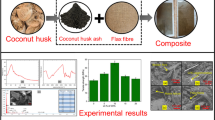The effects of metakaolin (MK) and basalt fiber (BF) on the performance of gypsum-based composites were investigated. BFs 6 and 12 mm long were used in concentrations of up to 0.8 wt.%. Mechanical tests were conducted on both dry and water-saturated specimens. It was found that their flexural and compressive strengths increased with content of BFs to 0.6%. However, the mechanical and durability properties worsened with fiber addition up to 0.8%. The samples with the 6-mm-long BFs showed better properties than those with the 12-mm-long ones. The addition of MK improved the shrinkage behavior of the composites, which could hinder an early formation of cracks in them.








Similar content being viewed by others
References
A. Oliver, “Thermal characterization of gypsum boards with PCM included: Thermal energy storage in buildings through latent heat,” Energy Build., 48, 1-7 (2012).
M. Garg and A. Pundir, “Investigation of properties of fluorogypsum-slag composite binders - Hydration, strength and microstructure,” Cem. Concr. Compos, 45, 227-233 (2014).
A. Vimmrová, M. Keppert, L. Svoboda, and R. Černý, “Lightweight gypsum composites: Design strategies for multifunctionality,” Cem. Concr. Compos, 33, No.1, 84-89 (2011).
G. Camarini and J.A. De Milito, “Gypsum hemihydrate-cement blends to improve renderings durability,” Constr. Build. Mater., 25, No.11, 4121-4125 (2011).
T. Toppi and L. Mazzarella, “Gypsum based composite materials with micro-encapsulated PCM: Experimental correlations for thermal properties estimation on the basis of the composition,” Energy Build., 57, 227-236 (2013).
V. N Paimushin and S. A. Kholmogorov, “Physical-mechanical properties of a fiber-reinforced composite based on an ELUR-P carbon tape and XT-118 binder,” Mech. Compos. Mater., 54, No.1, 2-12 (2018).
M. M. Shokrieh, and M. Memar., “Characterization of tensile and compressive properties of basalt/epoxy composites under stress corrosion conditions,” Mech. Compos. Mater., 53, No. 6, 759-766 (2018).
Y. F. Wu, “The effect of longitudinal reinforcement on the cyclic shear behavior of glass fiber reinforced gypsum wall panels: tests,” Eng. Struct., 26, No. 11, 1633-1646 (2004).
J. Branston, S. Das, S.Y. Kenno, and C. Taylor, C., “Mechanical behaviour of basalt fibre reinforced concrete,” Constr. Build. Mater., 124, 878-886 (2016).
P. Iyer, S. Kenno, and S. Das, “Mechanical properties of fiber-reinforced concrete made with basalt filament fibers,” J. Mater. Civ. Eng., 27, No. 11, 1-8 (2015).
C. Jiang, K. Fan, F. Wu, F. and D. Chen, “Experimental study on the mechanical properties and microstructure of chopped basalt fibre reinforced concrete,” Mater. Des., 58, 187-193 (2014).
C. High, H.M. Seliem, A. El-Safty, and S.H. Rizkalla,” Use of basalt fibers for concrete structures,” Constr. Build. Mater., 96, 37-46 (2015).
M. Gbozee, K. Zheng, F. He, and X. Zeng, “The influence of aluminum from metakaolin on chemical binding of chloride ions in hydrated cement pastes,” Appl. Clay Sci., 158, 186-194 (2018).
E. Kamseu, M. Cannio, E. A. Obonyo, F. Tobias, M. C. Bignozzi, V. M. Sglavo, and C. Leonelli, “Metakaolin-based inorganic polymer composite: Effects of fine aggregate composition and structure on porosity evolution, microstructure and mechanical properties,” Cem. Concr. Compos., 53, 258-269 (2014).
A. Souri, H. Kazemi-Kamyab, R. Snellings, R. Naghizadeh, F. Golestani-Fard, and K. Scrivener, “Pozzolanic activity of mechanochemically and thermally activated kaolins in cement,” Cem. Concr. Res., 77, 47-59 (2015).
M.F. Rojas and J. Cabrera, “The effect of temperature on the hydration rate and stability of the hydration phases of metakaolin-lime-water systems,” Cem. Concr. Res., 32, No. 1,133-138 (2002).
A. Demir, M. Ornek, M. Laman, A. Yildiz, and G. Misir, in: M. Karstunen and M. Leoni (eds.), Model studies of circular foundations on soft soils, Ch. 3, CRC Press, London, UK (2009), pp. 219-226.
V. R. Sivakumar, O. R. Kavitha, G. Prince Arulraj, and V. G. Srisanthi, “An experimental study on combined effects of glass fiber and Metakaolin on the rheological, mechanical, and durability properties of self-compacting concrete,” Appl. Clay Sci., 147,123-127 (2017).
J. J. Brooks and M. A. Megat Johari, “Effect of metakaolin on creep and shrinkage of concrete,” Cem. Concr. Compos., 23, No. 6, 495-502 (2001).
P.J.P. Gleize, M. Cyr, and G. Escadeillas, G., “Effects of metakaolin on autogenous shrinkage of cement pastes,” Cem. Concr. Compos., 29, No. 2, 80-87 (2007).
M. A. Caldarone, High-Strength Concrete: A Practical Guide, CRC Press, Boca Raton, FL, USA, 183-252 (2014).
M. Frías, M. I. S. De Rojas, and J. Cabrera, “Effect that the pozzolanic reaction of metakaolin has on the heat evolution in metakaolin-cement mortars,” Cem. Concr. Res., 30, No. 2, 209-216 (2000).
TS EN 13279-1. Gypsum Binders and Gypsum Plasters. Pt. 1: Definitions and Requirements, TSE, Ankara (2009).
TS EN 197-1. Pt. 1: Compositions and Conformity Criteria for Common Cements, TSE, Ankara (2010).
TS EN 13279-2. Gypsum Binders and Gypsum Plasters. Pt. 2: Test Methods, TSE, Ankara (2014).
C. Zhu, J. Zhang, J. Peng, W. Cao, and J. Liu, “Physical and mechanical properties of gypsum-based composites reinforced with PVA and PP fibers,” Constr. Build. Mater., 163, 695-705 (2018).
A. K. Schindler and K. J. Folliard, “Heat of hydration models for cementitious materials,” ACI Mater. J., 102, No. 1, 24-33 (2005).
F. Hernández-Olivares, I. Oteiza, and L. de Villanueva, “Experimental analysis of toughness and modulus of rupture increase of sisal short fiber reinforced hemihydrated gypsum,” Compos. Struct., 22, No. 3, 123-137 (1992).
A. Mobili, A. Belli, C. Giosuè, T. Bellezze, and F. Tittarelli, “Metakaolin and fly ash alkali-activated mortars compared with cementitious mortars at the same strength class,” Cem. Concr. Res., 88, 198-210 (2016).
Author information
Authors and Affiliations
Corresponding author
Additional information
Russian translation published in Mekhanika Kompozitnykh Materialov, Vol. 56, No. 3, pp. 561-574, May-June, 2020.
Rights and permissions
About this article
Cite this article
Yildizel, S.A. Material Properties of Basalt-Fiber-Reinforced Gypsum-Based Composites Made with Metakaolin and Silica Sand. Mech Compos Mater 56, 379–388 (2020). https://doi.org/10.1007/s11029-020-09889-z
Received:
Revised:
Published:
Issue Date:
DOI: https://doi.org/10.1007/s11029-020-09889-z




